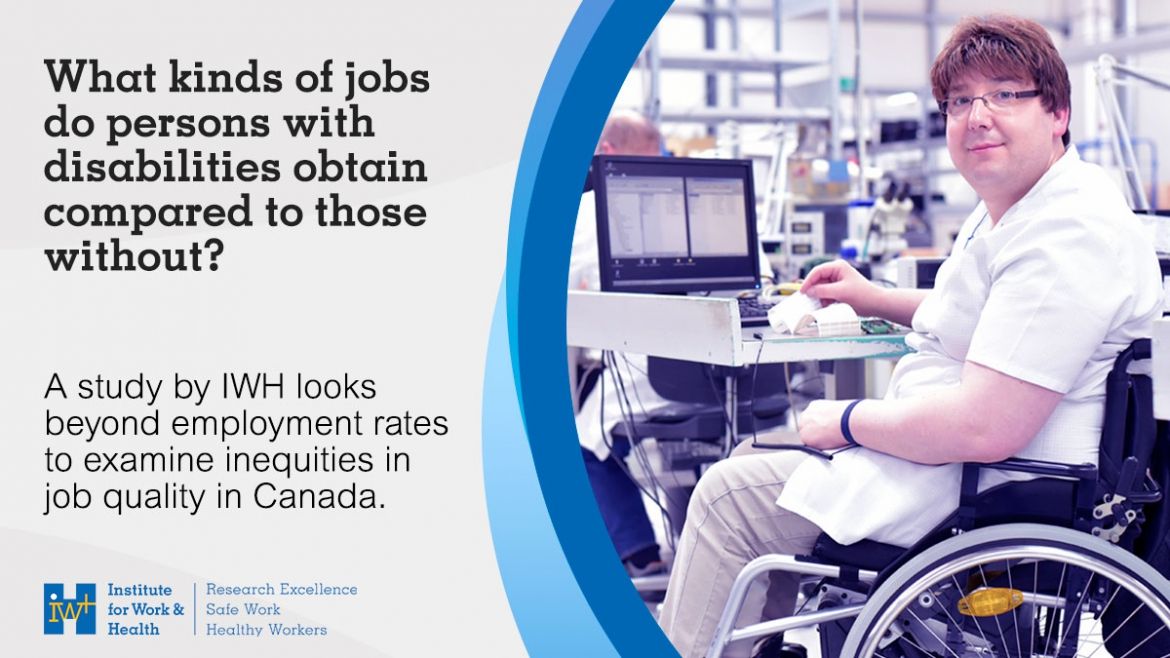Persons with disabilities are not only less likely than those without disabilities to find work. When they do, they are also more likely to find themselves in lower quality jobs.
This was a key finding from a recent study led by Institute for Work & Health (IWH) Associate Scientist Dr. Faraz Vahid Shahidi. The study, published in the Journal of Occupational Rehabilitation in April 2023 (doi:10.1007/s10926-023-10113-7), provides the most comprehensive picture yet of the employment quality of persons with disabilities in Canada. The paper is available free of charge; a webinar about this study was also held in April 2022 as part of the IWH Speaker Series.
In Canada, only three in five persons with disabilities are actively employed, compared to four in five persons without disabilities. Efforts to reduce employment inequities for persons with disabilities have aimed to close this gap in employment rates. However, employment rates are just one piece of the puzzle, says Shahidi. Simply put, participation in the workforce does not in and of itself guarantee inclusion—at least not in the form of high-quality employment,
he notes.
Not all jobs are created equal, and there are growing concerns about the declining quality of jobs in Canada and the rise of temporary, low-wage and other forms of precarious work, says Shahidi. As persons with disabilities are already known to face many barriers in the labour market, they may be more likely to end up in low-quality, precarious employment,
Shahidi adds.
The survey
With these concerns in mind, Shahidi sought to answer the question of how employment quality may differ for persons with disabilities compared to those without. To do this, he drew from an online survey of approximately 2,800 Canadian adults working at least 12 hours a week. The research team targeted recruiting efforts to make sure at least a third of the sample were individuals living with a physical, mental or cognitive disability. The survey was conducted in June 2020.
Survey participants were asked about 16 working conditions, ranging from job and income security to union membership and training opportunities. Based on their answers to these questions, the research team categorized participants into groups of similar job quality characteristics. We used an algorithm to identify underlying patterns in the data, and what these patterns represent are groups of workers who share a common set of employment characteristics,
says Shahidi.
Applying this method, they identified four distinct ‘types’ of employment:
- standard—jobs that are secure and rewarding;
- portfolio—jobs that are secure but demanding, with long and unpredictable hours;
- instrumental—jobs that are secure but unrewarding and leave the worker feeling trapped; and
- precarious—jobs that are insecure and unrewarding.
Shahidi found that, compared with workers who had no disabilities, workers with disabilities were 2.14 times more likely to be employed in the instrumental group, and 2.5 times more likely to be in the precarious group. These employment quality gaps generally held across different types of disability but were particularly pronounced for persons living with both a physical and a mental disability. Compared to those without a disability, persons living with both types of disabilities were more than three times more likely to be in instrumental jobs, and more than four times more likely to be in precarious employment than in standard employment.
Looking at individual working conditions, Shahidi found some are more prevalent among persons with disabilities, including: temporary and part-time employment, job and income insecurity, gig work, wage theft (i.e., unpaid wages), job lock (i.e., stuck in a job) and skill mismatch. Employment characteristics that were less common among persons with disabilities were flexible work schedules, training opportunities and positive safety climates.

Key takeaways
These findings indicate widespread inequities in the employment quality of Canadians with and without disabilities, suggesting that there is still a long way to go before persons with disabilities achieve full participation
in the labour market. These inequities go well beyond our conventional indicators of labour market inclusion, such as whether a person is employed or not
, Shahidi notes. The terms and conditions of employment matter.
For policy-makers, researchers and all others working on greater inclusion of persons with disabilities, we need to better distinguish between employment status (that is, having any job) and employment quality (that is, having a good-quality job),
Shahidi says. Beyond encouraging greater attachment to the labour market, our findings emphasize the importance of examining job security, wages, flexible work arrangements, job fit and training opportunities as particular areas in need of improvement when it comes to the job quality of persons with disabilities.
Addressing these gaps will require a combination of societal interventions (e.g., stronger employment standards legislation) and organizational policies (e.g., inclusive workplace practices), Shahidi adds. Noting that a sizable segment of the labour market is comprised of precarious jobs (for example, Ontario’s Changing Workplaces Review in 2017 puts the estimate at 30-32 per cent), he says a narrow focus on employment participation as an end in itself has the potential to exacerbate rather than mitigate the problem of social and economic exclusion.
We know from the public health literature that having a bad job can be as harmful to your physical and mental health as having no job at all. When it comes to promoting equity, the goal shouldn’t be just to create as many jobs as possible but to create opportunities for secure, gainful employment,
says Shahidi.